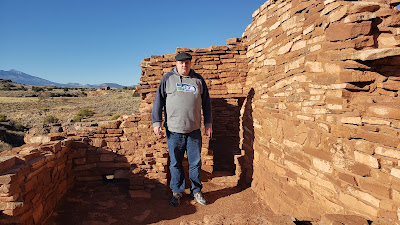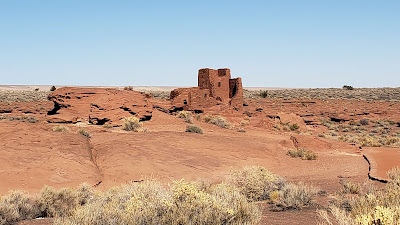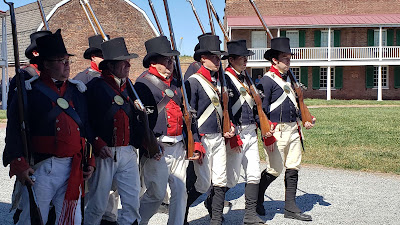Visited: Sept 2019
Nearby city: Baltimore, MD
"O say does that star-spangled banner yet wave
O'er the land of the free and the home of the brave?"
-from the poem "The Defence of Fort M'Henry" by Francis Scott Key, that would eventually become the lyrics of the National Anthem "The Star-Spangled Banner"
Fort McHenry was constructed in 1798-1800 to defend the large and important harbor of the port town of Baltimore, Maryland. It was designed by French architect Jean Foncin, and was named after local politician James McHenry, who had served as a delegate to the Continental Congress, a signer of the US Constitution, and Secretary of War to Presidents Washington and Adams.
During the War of 1812, the Fort was the site of the Battle of Baltimore on September 12-15, 1814. The origins of the War of 1812 are rather complex, and in many ways, were a continuation of the hostilities of the American Revolution. The young nation's alliance with France (which fluctuated between periods of strength and weakness) and its trade relationship with Britain caused a number of conflicts. Britain and France were historic rivals, and America's relationship with both countries would often put the nation between a proverbial rock and a hard place, diplomatically and economically. Britain's action of impressing (forcing men into military and naval service) American citizens and seizure of US cargo ships on the high seas also lead to very strained relations. Britain was also angered by America's expansion of influence and territory on the continent (including British Canada, Northwest Territory, Louisiana Purchase, and Spanish Florida), which threatened their economic interests and alliances with Native Tribes in the great hinterland.
The US Congress declared war on Britain on June 1, 1812. The beginning of the war did not go well for the Americans and their invasion of Canada failed and subsequently led to the British capture of Detroit. Britain sensed an opportunity to reclaim their former colonies and bring them back under authority of the Crown. Britain implented a strong blockade along the entire Atlantic coast (from Maine south to Florida) that crippled America's economy. In August 1814, the British Army soundly defeated the US Army at the Battle of Bladensburg and captured Washington DC, burning the White House and the US Capitol. The next month, September 1814, the British Army set its sights on the important port town of Baltimore.
The British Navy moved a number of warships up Chesapeake Bay. These ships would bombard the city from the sea, while the British Army would approach on land from the east. They planned to surround the city and force its surrender.
About 5,000 British regulars landed at North Point, about 5 miles east of the city. These regulars were met by the Maryland militia. The militia held strong for a few hours, but eventually they were forced to retreat. However, their organized retreat stalled the British advance. The militia delayed the British long enough to enable US Maj. George Armistead to fortify and defend the US Army position at Fort McHenry. Fort McHenry's main defense were 3 large cannons (an 18-, 24-, and 32-pounder). The Americans also deliberately sunk 22 ships at the entrance of Baltimore harbor in order to thwart the British naval advance.
A few days before the Battle of Baltimore, Francis Scott Key, a successful and prominent Maryland lawyer, was sent to Baltimore to negotiate with the British for the release of Dr. William Beanes, a civilian prisoner-of-war. Beanes had been arrested for arguing with British soldiers that had attempted to plunder his home. Key was taken to the British flagship, the HMS Tonnant, and met with British Major General Robert Ross over dinner. Key was successful in arranging the release of Dr. Beanes, however there was a condition, Key had to remain onboard the British ship until the conclusion of the Battle.
On September 13, 1814, Key witnessed the British bombardment on Fort McHenry while onboard the British ship in the Chesapeake Bay. That bombardment began at 6:00 in the morning, and it would continue for 25 hours. The sunken American ships at the entrance of the harbor were incredibly effective. The British ships couldn't get very close, and at that long range, the British rockets and cannon were not particularly accurate. Eventually, the British ran out of ammunition. As the land force stalled as well, the British fleet withdrew from the field of battle. Baltimore had been spared. Among the 1,000 American soldiers at Ft. McHenry, only 4 were killed and 24 wounded during the bombardment.
In the early morning hours of September 14, 1814, Key was overjoyed to see the American flag still flying proudly over Fort McHenry. The sight inspired Key to write a poem that he scrawled on the back of a letter he had in his pocket. He titled the poem "Defense of Fort M'Henry." This poem would later become the lyrics to the National Anthem.
After the British withdrawal at Baltimore, negotiations for peace began in earnest. In January 1815, the British were soundly defeated by Andrew Jackson's forces at the Battle of New Orleans. That, in combination with the passage of the Treaty of Ghent, ended the hostilities of the War of 1812.
At Fort McHenry National Monument and Historic Shrine, you can see a replica of the "Star-Spangled Banner" (the flag) that Key saw fly on that fateful morning.
The original Star-Spangled Banner is kept at the Smithsonian National Museum of American History in Washington DC. The Star-Spangled Banner is very unique, in that it has 15 red and white stripes (unlike the standard flag that has 13 stripes). When the flag was first designed, each stripe represented a state (one for each of the original 13 colonies). However, when Kentucky and Vermont joined the union, a star was added to the blue field, and a stripe was added for each new state as well (one white and one red). As it appeared that more and more states would join the union, it was decided that it would make the flag too big to add more stripes for each new state. Therefore, the design went back to 13 stripes, and stars were simply added to represent a new state.
Because we visited the monument in mid-September, we just happened to be there at the 205th anniversary of the battle. Due to the anniversary there were lots of historical re-enactors and demonstrations during our visit. That made it very special. They had a military parade (complete with a band) and changing of the guard, an in-depth look at 19th century cannons and how they were loaded etc., and a firearms demonstration. Explore the museum/visitor center to learn all about the War of 1812 and the Battle of Baltimore. Then tour the grounds of the Fort and walk along the harbor.
bunch of cannons lined up
Baltimore harbor
this is the sally port, the entrance to the Fort
firearm demonstration
Key's poem "Defence of Fort M'Henry" was set to the tune of a popular British drinking song "To Anacreon in Heaven" and became known as "The Star-Spangled Banner." The US Navy adopted "The Star-Spangled Banner" for official use in 1889. In 1916, Pres. Woodrow Wilson ordered that it be played at military and other official executive occassions. Finally, in 1931, the US Congress officially designated "The Star-Spangled Banner" as the National Anthem.
The lyrics of Key's poem:
O say can you see, by the dawn's early light,
What so proudly we hailed at the twilight's last gleaming,
Whose broad stripes and bright starts through the perilous fight,
O'er the ramparts we watched, were so gallantly streaming?
And the rocket's red glare, the bombs bursting in air,
Gave proof through the night that our flag was still there;
O say does that star-spangled banner yet wave
O'er the land of the free and the home of the brave?
On the shore dimly seen through the mists of the deep,
Where the foe's haughty host in dread silence reposes,
What is that which the breeze, o'er the towering steep,
As it fitfully blows, half conceals, half discloses?
Now it catches the gleam of the morning's first beam,
In full glory reflected now shines in the stream:
'Tis the star-spangled banner, O long may it wave
O'er the land of the free and the home of the brave.
And where is that band who so vauntingly swore
That the havoc of war and the battle's confusion,
A home and a country, should leave us no more?
Their blood has washed out their foul footsteps' pollution.
No refuge could save the hireling and slave
From the terror of flight, or the gloom of the grave:
And the star-spangled banner in triumph doth wave,
O'er the land of the free and the home of the brave.
O thus be it ever, when freemen shall stand
Between their loved homes and the war's desolation.
Blest with vict'ry and peace, may the Heav'n rescued land
Praise the Power that hath made an preserved us a nation!
Then conquer we must, when our cause it is just,
And this be our motto: 'In God is our trust.'
And the star-spangled banner in triumph shall wave
O'er the land of the free and the home of the brave!
the museum contains Key's original draft of the poem
Tara and I had a great time at this historic site, especially with all the re-enactors and demonstrations going on for the anniversary of the battle.














































































